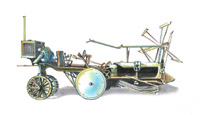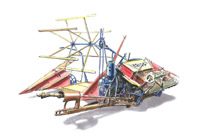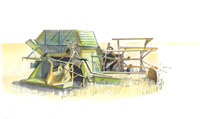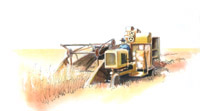| c. 50 |
— |
In his “Naturalis historica” Gaius Plinius (23 – 79 AD) from Rome describes a reaping machine: a box on a chassis pushed by donkeys. On the front of the box there were iron teeth which broke off the ears of corn; the ears accumulated in the box |
|
— |
A copy of the machine, made using pictures from the ancient world, was fully functional! |
| 1799 |
— |
The first verifiable patent for a reaping machine is granted to the English inventor Joseph Boyce |
| 1826 |
— |
| In Scotland the Revd Patrick Bell invents the reaping machine which works on the scissor principle still used today |

|
|
Bell–reaping machine 1826
|
|
|
| 1831 |
— |
| In Steelte’s Tavern (Virginia, USA) blacksmith Cyrus Hall McCormick introduces the first corn reaper in the world under the name of the “Virginia Reaper” |

|
|
McCormick’s Virginia Reaper, USA around 1850
|
|
|
| 1835 |
— |
The first combine harvester is patented in the USA: Hiram Moore develops a machine that is capable of mowing, threshing and winnowing. Width of cut: 4.60 m |
| 1841 |
— |
In England Alexander Dean builds the first threshing machine powered by steam |
| 1855 |
— |
Production of the “Virginia Reaper” begins in England |
| 1856 |
— |
The first corn reaper is imported into Germany from England |
| 1857 |
— |
John F. Appleby from Wisconsin (USA) invents the twine binder (knotter) |
| 1860 |
— |
The first combine harvesters with a cutting width of several metres come into use in the USA: they are drawn by up to 30 horses |
| 1872 |
— |
The Deering company (Chicago, USA) builds the first reaper–binder |
| 1886 onwards |
— |
| The first trials using self–propelling combine harvesters in the USA |

|
|
McCormick self–propelling combine harvesters, around 1900
|
|
|
| 1889 |
— |
500 combine harvesters (horse–drawn) are in use in California |
| 1900 |
— |
The Fahr company builds the first German reaper for a harnessed team with a manual grain storage system |
| 1911 |
— |
The Holt Company of Stockton uses the first combustion engines in combine harvesters |
|
— |
In Germany the International Harvester Company mbH in Neuss am Rhein begins mass producing grain reapers |
| 1922 |
— |
Massey–Harris (USA) uses a combustion engine to power its combine harvester |
| 1923 |
— |
In Germany August Claas invents the knotting hook with an upper lip for binding sheaves securely |
| 1927–32 |
— |
15 American combine harvesters are tested on German fields. Conclusion: the machines will have to be modified for use in Europe |
| 1927 |
— |
| First reaper–binder with power take–off drive made by Krupp |

|
|
reaper–binder, Krupp 1927
|
|
|
| 1931 |
— |
The Deutsche Industriewerke company in Berlin–Spandau construct the first combine harvester to suit conditions in Germany (FATH construction) |
| 1935 |
— |
The Massey–Harris company (USA) builds the first self–propelling combine harvesters with combustion engines |
| 1936 |
— |
| The first reaper–thresher–binder (MDB) is brought onto the market by the Claas company from Germany. It is drawn by a tractor and designed specifically for Europe and its low–growing, very dense cereal crops |

|
|
Claas MDB with power take–off drive drawn by a tractor, around 1940
|
|
|
| 1951 |
— |
| The Fahr company introduces the MD–1 – the first free cutting self–propelled harvester – onto the German market (driven by a diesel engine, cutting width 2.10 m) |

|
|
self–propelled harvester Fahr MD–1 prototype 1951
|
|
|
| 1960 |
— |
Lely–Dechentreiter introduces the first fold–away cutter bar (for driving on roads) |
|
— |
Other later information from the history of combine harvesters cannot be explicitly ascribed to any one manufacturer |







